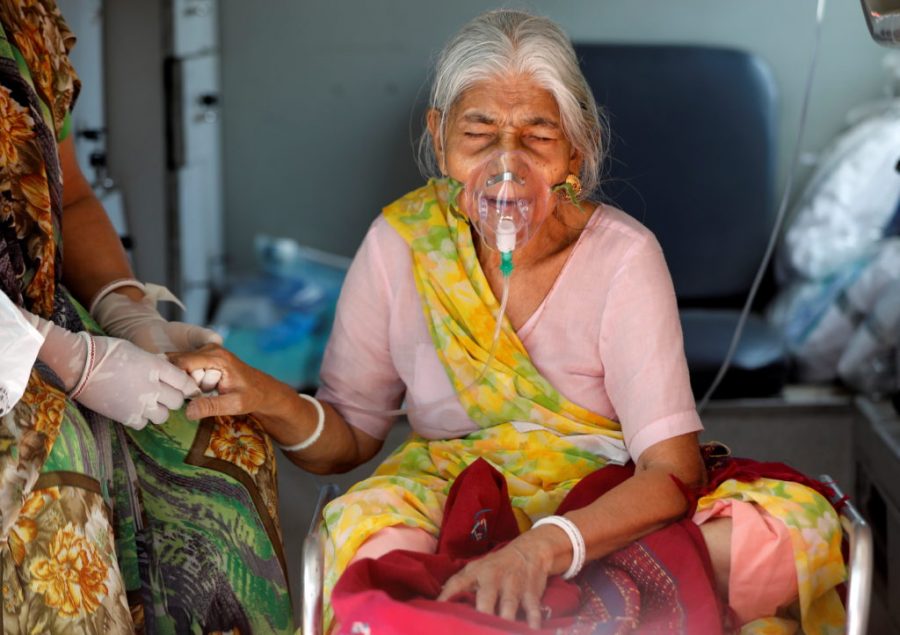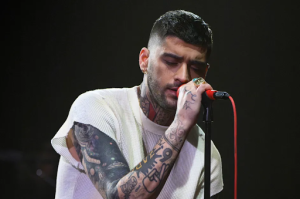India faces crisis with accelerating outbreak of COVID-19
COVID-19 strain found in India labeled ‘variant of concern’
Photo courtesy of pbs.org (REUTERS)
Lilaben Gautambhai Modi, 80, wearing an oxygen mask, sits inside an ambulance as she waits to enter a COVID-19 hospital for treatment, amidst the spread of the coronavirus disease (COVID-19), in Ahmedabad, India, May 5, 2021. REUTERS/Amit Dave
May 11, 2021
India is confronting a surge in COVID-19 cases, as a highly-contagious strain of the virus has been identified and labeled as a “variant of concern” by the World Health Organization (WHO).
India has reported high death tolls staggering to “22.66 million with 246,116 deaths” according to Reuters, making it one of the worst waves of the virus the world has seen yet. Hospitals are running out of beds and oxygen, and “nearly 90% of the country’s oxygen supply – 7,500 metric tonnes daily – is being diverted for medical use, according to Rajesh Bhushan, a senior health official. That’s nearly three times higher than was consumed every day at the peak of the first wave in mid-September last year,” according to reporting from the BBC.
Experts suspect that India’s cases and death toll statistics are not accurate with reports of undercounting. Whether it be due to civilians’ shame of reporting a link to the virus or negligent politicians, deaths are going uncounted.
“It’s a complete massacre of data,” said Bhramar Mukherjee, an epidemiologist at the University of Michigan who has been following India closely, told the New York Times. “From all the modeling we’ve done, we believe the true number of deaths is two to five times what is being reported.”
The Times article reported from the perspective of a crematorium worker from Western India who describes the conditions as a “never ending assembly line of death.” Upon writing the cause of death on slips distributed to the families, he has been instructed to write “sickness” by his bosses.
The variant of the virus was first found in India in December. According to Reuters, the variant “contains two key mutations to the outer “spike” portion of the virus that attaches to human cells, said senior Indian virologist Shahid Jameel.” WHO’s COVID-19 technical lead, Maria Van Kerkhove, claims that there is increased transmissibility of the variant that has been demonstrated in preliminary studies.
Correlation between the variant and India’s surge in cases is undetermined. The cause is also being directed to large social gatherings that have been taking place in India. WHO chief scientist Soumya Swaminathan claims that studies are underway to examine the transmissibility, severity, and its response to vaccination.
‘”What we know now is that the vaccines work, the diagnostics work, the same treatments that are used for the regular virus works, so there is really no need to change any of those,’ Swaminathan said.”
Apart from the supposed transmissibility of the variant, India’s slow-moving vaccinations and large gatherings are up for blame. According to the New York Times, “Less than 10 percent of Indians have gotten even one dose, despite India being the world’s leading vaccine manufacturer.”
Prime Minister Narendra Modi is receiving criticism for his poor management of the crisis. Modi held a political rally with thousands in attendance in April with little masks and social distancing. Modi also refused to shut down a Hindu pilgrimage to the Ganges River where millions bathed.
Criticism pursues as Modi remains unwilling to initiate a lockdown. According to NPR, “Last year, Modi imposed a 21-day national lockdown that was credited with helping contain the virus. Now calls are growing for another one, but Modi has been reluctant to make a similar move.”








